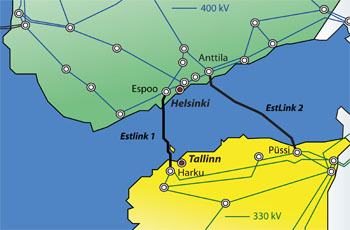EstLink 2 – second high-voltage direct current link between Finland and Estonia
EstLink 2 has been handed over to its owners and made available for commercial operations on 6th of February.
The transmission system operators (TSOs) in the region of the Baltic Sea have drawn up a shared transmission grid analysis, which examines the linking of the Baltic countries to the electricity market in the Nordic countries and Continental Europe. The analysis completed in early 2009 revealed a need to construct a new electricity transmission connection, EstLink 2, between Finland and Estonia.
The Finnish TSO Fingrid Oyj and the Estonian TSO Elering AS have launched preliminary planning for the construction of this second high-voltage direct current (HVDC) interconnection between the two countries in spring 2009. Fingrid has also made a conditional capital investment decision on Estlink 2 (19th of May 2010).
The impacts of the project on the water system and fishing industry in the sea area were analysed during the summer and autumn of 2009. The cross-border line permit, the permit required by the Finnish Water Act, the expropriation permit http://www.maanmittauslaitos.fi/toimitukset/lunastustoimitus-nikuviken-anttila-estlink-2-porvoon-kaupungissa and the economic region permit for the direct current link were obtained from the authorities in November and December 2010.
All the main contracts were signed with the suppliers in 2010. Earthwork at the Anttila substation in Porvoo in Finland was completed in the autumn of 2011. The submarine cable was laid at the bottom of the sea in autumn of 2012 and the testing of cable and separate contracts were completed in autumn of 2013.
The tests between Finland and Estonia began 22th of November 2013 and the trial period was during 6th of December 2013 to 6th of February 2014. During the trial period EstLink 2 was already available for commercial operations.

HVDC interconnection Estlink completed in 2006 and EstLink 2 interconnection under construction.
The EstLink 2 HVDC interconnection between Finland and Estonia has transmission capacity of 650 megawatts, which increases the total transmission capacity between the countries to 1,000 megawatts. The total length of the link is approx. 170 km, some 14 km of which is overhead line in Finland, about 145 km submarine cable laid on the bottom of the Gulf of Finland, and about 11 km underground cable in Estonia.
The budget of the project is around 320 million euros, which will be shared between the parties. The Commission of the European Union has confirmed that the construction of EstLink 2 will receive 100 million euros in investment subsidy from the EU as part of a more extensive economy recovery package.
Foremost parts of the project
Environmental impact study, route selections, seabed surveys, and application for various permits in Finland and Estonia.
Reinforcement of the electricity transmission grid in Estonia.
Earthwork at Anttila and Nikuviken in Finland. Contractor Konevuori Oy.
Substation upgrades in Finland (Anttila) and Estonia (Püssi). The contractor in Finland is Empower Oy, and in Estonia the regional office of Siemens Osakeyhtiö.
Construction of HVDC (High Voltage Direct Current) converter substations in Finland (Anttila) and Estonia (Püssi). The contractor is a consortium of Siemens AG and Siemens Osakeyhtiö.
Construction of the direct current overhead line in Finland from the converter substation to the terminal point of the submarine cable at Nikuviken. The contractor is the French company ETDE.
Manufacture and laying of the submarine cable, and construction of the direct current underground cable in Estonia from the converter substation at Püssi to the terminal point of the submarine cable. The contractor is Nexans Norway AS.
Further information on the project is available from Project Manager Risto Ryynänen, tel. +358 (0)30 395 5219.

The sole responsibility of the EstLink2 publication lies with the author. The European Union is not responsible for any use that may be made of the information contained therein.
Attachments
- EstLink 2 Newsletter December 2013
- EstLink 2 Newsletter July 2012
- EstLink 2 Newsletter May 2011
- Transmission system evolving in Baltic Sea region - Cornerstone laid in Estlink 2 project 16.11.2011
- Contractors chosen for Finland–Estonia submarine connection 23.12.2010
- New submarine cable between Finland and Estonia confirmed 29.9.2010
- EU subsidy for Finland–Estonia submarine cable link 12.7.2010
- Fingrid's capital investment decision on submarine cable link to Estonia 20.5.2010
- Preliminary agreement signed on Estlink 2 15.2.1010
- Cable project obstacles: Electricity cable between Estonia and Finland would intensify electricity market in Baltic Sea region 20.8.2009
- Grid plan shared by Nordic countries and Baltic region completed 11.2.2009

